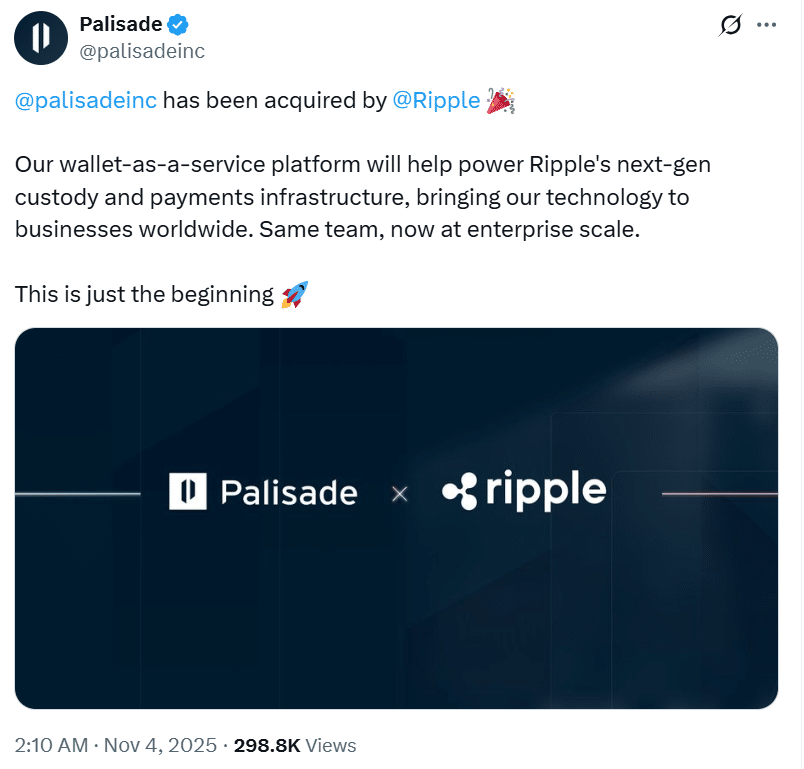Ripple Acquires Palisade to Boost Digital Asset Custody and Institutional Crypto Services
Ripple has intensified its focus on institutional crypto infrastructure through its latest move into Ripple digital asset custody. The blockchain company announced the acquisition of Palisade.
Palisade is a specialist in digital asset wallet and custody solutions. The acquisition, revealed on November 3, 2025, underscores Ripple’s ambition to become a one-stop platform for secure, compliant, and scalable digital finance operations.
Ripple Digital Asset Custody Strengthened by Palisade Acquisition
The acquisition of Palisade positions Ripple as the digital asset custodian at the heart of enterprise crypto operations. By integrating Palisade’s cutting-edge “wallet-as-a-service” technology, Ripple strengthens its ability to deliver secure transaction tools to businesses.
 Source: X
Source: X
This development follows Ripple’s year-long expansion strategy, marked by several strategic buyouts, including GTreasury and Hidden Road. Together, these acquisitions form a foundation for Ripple custody to become a leader in institutional-grade crypto management.
Overview of the Deal
The Palisade acquisition introduces multi-party computation (MPC), zero-trust architecture, and multi-chain compatibility into Ripple’s custody framework. These advanced technologies significantly enhance Ripple custody.
They facilitate smooth, secure, and effective functions through various blockchain environments. The major networks that this integration supports include the XRP Ledger, Ethereum, and Solana and they serve to strengthen the institutional-grade infrastructure at Ripple.
Also Read: Why XRP Still Matters in Ripple’s Strategy Despite RLUSD’s Growing Influence
Ripple affirmed that the infrastructure of Palisade will be incorporated not only into Ripple Custody but also into Ripple Payments to enable the institutions to settle, liquidity, and treasury processes on the same unified platform.
Ripple Strengthens Its Institutional Network
With Ripple digital asset custody, institutions like DBS, Societe Generale–FORGE, BBVA, and Absa Bank have already adopted Ripple’s enterprise-grade solutions. Ripple President Monica Long emphasized that “secure digital asset custody unlocks the crypto economy,”,
Describing the company’s technology as a bridge between traditional finance and decentralized networks. Her comments highlight how Ripple custody is rapidly becoming essential for banks and corporates seeking trusted partners in crypto transactions.
Building a Multi-Asset Financial Ecosystem
Ripple digital asset custody is evolving into a cornerstone of the company’s broader multi-asset ecosystem. Earlier in October, Ripple launched Ripple Prime, a U.S.-based prime brokerage, leveraging its $1.25 billion Hidden Road acquisition.
This followed the $1 billion purchase of GTreasury, which integrated digital settlements into legacy financial systems. These investments strengthen Ripple’s infrastructure for Ripple custody, merging traditional financial tools with blockchain-based innovation.
Regulatory Momentum and Compliance
Ripple digital asset custody operates within a strong regulatory foundation—Ripple holds over 75 global licenses, giving it significant credibility in compliance-sensitive markets.
By integrating Palisade’s secure wallet technology with Ripple’s strong compliance-first approach, Ripple custody sets a new benchmark in the industry. This combination positions it as a leading model for responsible innovation in the evolving world of crypto finance.
U.S. Market Expansion
Ripple recently launched a digital asset spot prime brokerage for U.S.-based institutional clients, reinforcing the strength of Ripple custody. This move further supports regulated crypto trading and settlement services under Ripple’s expanding institutional framework.
Michael Higgins, CEO of Ripple Prime and former Hidden Road executive, stated that Ripple’s new services will provide a “comprehensive suite” of tools tailored to institutional trading strategies.
Ripple’s Vision for 2025 and Beyond
The timing of the announcement—just before Ripple’s annual Swell conference in New York—signals a major pivot in strategy. Ripple digital asset custody is now at the center of Ripple’s identity, positioning the firm as a full-service crypto financial platform.
As traditional finance merges with blockchain-based systems, Ripple’s infrastructure could serve as a benchmark for regulated and transparent crypto integration.
Conclusion
Ripple’s acquisition of Palisade reaffirms its leadership in digital finance and institutional blockchain adoption. By embedding advanced wallet and custody technology into Ripple custody, the company is not just following the crypto evolution.
With a clear regulatory edge, technological depth, and a growing institutional network, Ripple digital asset custody stands as a crucial component of the company’s mission to unify global finance under a secure, interoperable framework.
Also Read: Ripple’s Middle East Expansion Signals New Era for XRP and RLUSD
Appendix: Glossary of Key Terms
Ripple Digital Asset Custody – Ripple’s secure infrastructure for storing and managing digital assets for institutions.
Palisade – A digital wallet and custody provider acquired by Ripple.
Multi-Party Computation – A cryptographic method enhancing transaction security.
Zero-Trust Architecture – A framework that assumes no user or system is automatically trusted.
Multi-Chain Compatibility – The ability to support multiple blockchain networks.
Ripple Prime – Ripple’s institutional prime brokerage platform.
Hidden Road – A digital asset firm acquired by Ripple for prime brokerage capabilities.
Frequently Asked Questions Ripple Digital Asset Custody
1: What is Ripple digital asset custody?
Ripple digital asset custody refers to Ripple’s institutional-grade infrastructure that enables secure storage, management, and transfer of cryptocurrencies and tokenized assets.
2: Why did Ripple acquire Palisade?
Ripple acquired Palisade to enhance its custody technology, integrating MPC security, multi-chain support, and zero-trust systems into Ripple digital asset custody.
3: How does Ripple digital asset custody benefit institutions?
It allows fintechs, banks, and corporates to perform settlements, treasury management, and cross-chain operations through a compliant and unified system.
4: What are Ripple’s other major acquisitions in 2025?
In 2025, Ripple also acquired Hidden Road for $1.25 billion and GTreasury for $1 billion, expanding its Ripple digital asset custody and payments ecosystem.
Read More: Ripple Acquires Palisade to Boost Digital Asset Custody and Institutional Crypto Services">Ripple Acquires Palisade to Boost Digital Asset Custody and Institutional Crypto Services
You May Also Like

CaaS: The "SaaS Moment" for Blockchain

CME Group to Launch Solana and XRP Futures Options
